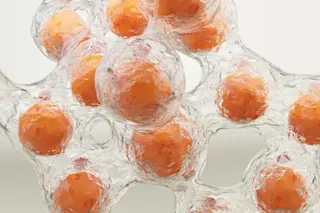At 6 a.m. workers are inspecting shipments of gleaming ice-packed fish at IMP Foods, a company in San Mateo, California, that supplies sushi-grade specimens to Japanese restaurants and a coterie of some of the most famous—and famously picky—American chefs. Harold McGee is in his element. “Look at that, with that schnoz, and a whip coming out of its tail,” he says, stooping over what turns out to be acornet fish, a long, bony creature with a fluted tube for a snout, a strange rear end, and an altogether alarming red color. “In Japan we call it aka-yagara, which means ‘red arrow,’” says Glenn Sakata, IMP’s general manager. “It makes wonderful broth.”
A golden threadfin bream, itoyoriin Japanese, also catches McGee’s eye. Favored for sashimi, it’s quite lovely, with silver skin, luminous yellow stripes, a tail that blushes deep pink. Sakata mentions in passing that both fish are bought by the French Laundry, Thomas Keller’s four-star temple to cuisine in Napa Valley. The sea bream shimmers with freshness in its box of shaved ice. McGee, who is wearing a regulation-issue hairnet, bows over it and draws a deep, appreciative breath.
McGee is the author of On Food and Cooking: The Science and Lore of the Kitchen,a doorstop of a book that first appeared in 1984 and became an instant classic. Tall, bearded, and unapologetically bookish, he’s America’s premier food wonk. He likes nothing better than surfing journals the likes of Cereal Chemistry, Poultry Science, and The Bulletin of the Japanese Society of Scientific Fisheries.In fact, he’s made a career of turning huge amounts of arcane food science, centuries of history and culture, and wonderfully oddball,just-for-the-heck-of-it facts into a good read for curious cooks and eaters. Somehow he seems uniquely up to the task. How many people have studied both physics and English literature at Caltech, earning a hybrid bachelor of science degree in literature? McGee has become the go-to guy for such questions as: How much oil can mayonnaise absorb?Why do red beans cause gas? How do you deal with an overdose of wasabi?When it came to fish, though, the original On Food and Cooking had little to say. Back then, meat research meant red meat. Fish barely got a mention.
Twenty years later, “there’s been an explosion of information on the subject,”McGee says. Fishing has become “a more important and visible industry.”Fish stocks worldwide are under pressure as never before, “so national governments put more resources into research because of problems with sustainability and developing aquaculture.” Seafood consumption,meanwhile, is rising, driven in part by health concerns and America’s love affair with sushi. Sales of sushi in the United States have been booming, says Sakata. Now we’re buying tuna rolls in supermarkets.
So McGee’s new On Food and Cooking, 10 years in the making and almost twice the heft of the original, now includes an entire section on fish.
Fish,especially ocean fish, as McGee points out in his new book, live in a very different world from ours and that of the other animals we eat.The rules are different from those for cattle, pigs, and chickens. To understand the character of fish as food—what makes it taste and smell the way it does, why you like it, and why you sometimes don’t—you must bear in mind the adaptations fish have made to life in water. Also,judging from McGee’s example, you have to follow your schnoz.
As you step through the door into the cool sanctuary of IMP’s fish market,there’s a slight briny edge to the air that instantly recalls the seaside. “Seacoast smell,” announces McGee. It’s the smell of bromophenols synthesized by algae from the bromine in seawater. In coastal areas, these bromophenols are propelled into the air by the action of waves. “Think of waves dashed on rocks,” says McGee. Oceanfish accumulate the phenols in their tissues by eating algae or other algae eaters. A nice fresh fish is never smelly or “fishy,” says McGee. But its bromophenols can magically conjure up sea air.
He runs his hands over the skin of an iced locally caught king salmon that will be dinner tonight for family and friends in nearby Palo Alto.Wild salmon has an aroma all its own that appears to arise from a particular diet, notes McGee. He rubs his hands together to warm them and develop the traces of scent he has picked up from the fish, then cups his hands around his nose: “Unmistakably salmony.” The scent is believed to be partly due to their fats and partly to the pink as taxanthins salmon acquire from eating crustaceans, which in turn create them from the beta-carotene they’ve obtained from algae. When the fish is cooked, as taxanthins give rise to fruity, floral tastes.
If a fish is spanking fresh, you can sometimes catch a surprisingly plantlike aroma, says McGee, continuing the tutorial. Fish, especially cold-water fish, have oily, unsaturated fats that remain fluid at low temperatures. Their fats are more like the polyunsaturated oils of plants than the fats of other animals. What’s more, fish skin, like plant leaves, contains lipoxygenases—and these enzymes break down the long unsaturated fatty molecules of fish into many of the same smallaromatic fragments found in plants. In Japana legendary freshwater fish named ayu, or sweetfish, a native ofmountain streams, is said to have melon and cucumber aromas. “Do you have ayu?” asks McGee, hopefully. (Ayu rhymes with “yahoo.”) IMP Foods supplies the little fish to Charlie Trotter’s in Chicago, among other restaurants. But after checking, Sakata is sorry to say the market is all out.
Fleeting sea and plant aromas are delightful signs of freshness in a fish. But after a fish is caught and killed, other aromas develop. All meats, of course, are perishable, but in fish the process occurs faster—largely because fish are designed for temperatures lower than those on dry land. Their unsaturated fats, an asset in cold ocean water, become a liability in our environment: They are easily oxidized—broken down by oxygen into fragments that smell and taste stale. Their cold-adaptedenzymes rev up in our warmer air. Even the bacteria normally clinging to their surfaces grow faster. Much of this enzymatic and bacterial activity has odiferous consequences. If a fish is not properly chilled,kept on ice like the fish at IMP, it’s going to smell bad.
The principal smell contributing to “fishiness,” says McGee, is a compound called trimethylamine, or TMA. It is derived from trimethylamine oxide,or TMAO, which is not in itself objectionable. TMAO is one of several amines and amino acids that ocean creatures accumulate inside their cells to buffer them against a fatal influx of sea salt. (Seawater is 3percent salt; the optimal level of dissolved minerals in animal cells is about1 percent.) Some amino acids—sweet glycine and savory glutamate—turnout to be big contributors to seafood’s delicious repertoire of flavors. Not TMAO, though. The chemical is tasteless but is the precursor of that unappetizing smell. Once a fish is dead, TMAO is gradually converted to TMA by bacteria proliferating on the surfaces of the fish. (Freshwater fish like ayu live in an environment less salty than the inside of their cells, so they don’t accumulate amino acids and amines. Their flesh is mild tasting and slower to turn smelly.)
Luckily,“fishiness” in an ocean fish past its prime can be reduced in the kitchen. A thorough rinsing in cold water helps minimize odors.“Oxidized fats, bacteria, and TMA on the surface can be rinsed off with tap water,” says McGee. “And acidic ingredients—lemon juice, vinegar,tomatoes—help in two ways.” They encourage stale-smelling fragments to react with water and become less volatile, and they induce TMA to bond with water and other molecules so they never escape the fish’s surface to assault your senses. As for truly spoiled fish, let’s just say that by the time proteins are being broken down into skatole, putrescine,cadaverine, and hydrogen sulfide, you probably won’t want that fish inyour mouth.
Refrigeration retards spoiling, but it can’t stop decay. That’s especially true for deep-sea fish with cold-adapted physiologies. “Enzymes and bacteria typical of our warm-blooded meat animals normally work at 100 degrees Fahrenheit and slow to a crawl in a refrigerator at 40°F. But the same refrigerator feels perfectly balmy to deepwater fish enzymes and bacteria,” McGee writes in his new book. The key, then, to keeping fish as fresh as possible is ice. “Fish lasts nearly twice as long in a 32°F slush as it does at typical refrigerator temperatures,” says McGee, who recommends flaked or finely chopped ice because it makes better contact with contours than large cubes or slabs.
At IMP Foods, ice is everywhere. As fish get moved, unpacked, checked, and repackaged, ice is involved every step of the way. You see ice and you hear ice—the crash of ice chips dumped on metal surfaces, the sloshing of slush, the soft noises made by shaved ice getting shoved around.
We end the morning in the fish market’s kitchen, where it’s warm. Sakata has good news. He has located an ayu.
The fish, though flown in from Japan,is still so firm, clear-eyed, and gleaming fresh, it appears lacquered.“It looks just caught,” says McGee. “Its mucus layer is completely intact. Let’s see if I can get the gills to open up a little bit,” he says, gently lifting the gill flap. “The gills are often the first part of a fish to go. Their red turns brown with oxidation. And since gills are full of bacteria, because that’s where the water is filtered, they can generate unpleasant aromas. So let’s take a sniff.”
He puts his nose to the gills, which are a healthy bright red.
“Ah, I think I smell the melon!” he exclaims. “Can you smell it? I’ve been reading about this fish for years, in the abstract, because I’ve never seen it in a market,” he says in a rush. “In Japan, they’ve analyzed the aroma, because that’s what people say they value most about this fish, and they’ve found some of its compounds are exactly the compounds you find in melons and cucumbers.”
“He knows more about this fish than me,” Sakata says.
“That’s what’s so cool,” says McGee. “Once somebody points out to you that this fish smells like watermelon, all of a sudden there’s another dimension to the experience of eating it.”
Which we do then and there—the fish is simply sprinkled with sea salt and grilled whole. Glenn Sakata splits the fish open like a book, and we goat its mild, surprisingly soft white flesh with chopsticks, enjoying every last sweet morsel. Ayu, the sweetfish. “Who could ask for anything more?” says Harold McGee.
On Food and Cooking: The Science and Lore of the Kitchen An excerpt from the newly revised book by Harold McGee Copyright 1984, 2004. Published by Scribner, a division of Simon & Schuster.
People in many parts of the world enjoy eating ocean fish and shellfish raw.Unlike meats, fish have the advantage of relatively tender muscle and a naturally savory taste, and are easier and more interesting to eat raw.They offer the experience of a kind of primal freshness. The cook may simply provide a few accompanying ingredients with complementary flavors and textures, or firm the fish’s texture by means of light acidification (ceviche), salting (poke), or both (anchovies briefly cured in salt and lemon juice). And raw preparations don’t require the use of fuel, which is often scarce on islands and coastlines.
Probably the commonest form of raw fish is sushi, whose popularity spread remarkably in the late 20th century from its home in Japan. The original sushi seems to have been the fermented preparation narezushi; sushi means“salted” and now applies more to the flavored rice, not the fish. (The familiar bite-sized morsels of raw fish and lightly salted and acidified rice are nigiri sushi, meaning “grasped” or “squeezed,” since the rice portion is usually molded by hand. The mass-produced version of sushi found in supermarkets is formed by industrial robots.)
Many cultures from the Arctic to the tropics have recruited microbes to grow on fish and transform their texture and flavor. But the world center of fish fermentation is eastern Asia, where it has served two important purposes: to preserve and put to use the large numbers of small fish that inhabit the coastal and inland waters; and to provide a concentrated source of appetite-stimulating flavors—above all the savory monosodium glutamate and other amino acids—for a diet dominated by bland rice.
Fish fermentation apparently arose several thousand years ago in the freshwaters of southwest China and the Mekong River region. It then spread to the coastal deltas and was applied to ocean fish. Two broadly different techniques evolved: simply salting a mass of small fish or fish parts and allowing it to ferment; and salting larger fish lightly, then embedding them in a fermenting mass of rice or other grains, vegetables, or fruits. In the simple fermentation, the proportion of salt is usually enough by itself to preserve the fish from spoilage, and bacteria are important mainly as flavor modifiers.But in the mixed fermentation, a smaller dose of salt preserves the fish for just a few weeks while the plant-based ingredients feed the same microbes that sour milk or turn grape juice into wine. The fish is then preserved by the microbes’ acids or alcohol, and flavored by the many byproducts of their growth.
Of the many Asian fermentations that mix fish and grains, one of the most influential has been the Japanese narezushi, the original form of modern sushi. The best-known version is funa-zushi, made with rice and goldfish carp (Carassius auratus) fromLake Biwa, north of Kyoto.Various bacteria consume the rice carbohydrates and produce a range oforganic acids that protect against spoilage, soften the head and backbone, and contribute to the characteristic tart and rich flavor, which has vinegary, buttery, and cheesy notes. In modern sushi, made with pristinely fresh raw fish, the tartness of narezushi survives through the addition of vinegar to the rice.














